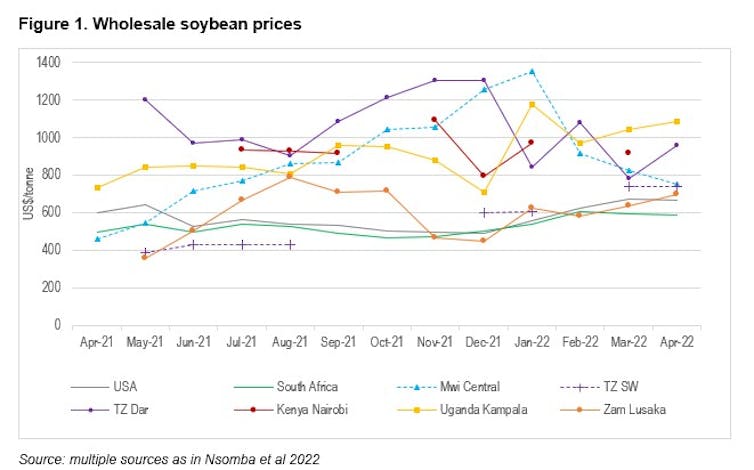[ad_1]
Small and medium-scale farmers and agri-businesses in east and southern Africa are getting a uncooked deal. To succeed they want truthful and built-in regional markets. Analysis by the Centre for Competitors, Regulation and Financial Improvement has highlighted the necessity for higher integration of regional economies as a step in the direction of meals safety within the area.
Highly effective business pursuits, excessive transport prices and poor entry to services resembling for storage imply that small and medium-scale farmers are sometimes not getting truthful costs for the meals they develop. Truthful costs are those who meet demand and canopy cheap prices of provide together with transport throughout borders.
In the course of the course of our analysis we got here throughout examples of how the percentages are stacked towards most small and medium-scale farmers. Take the expertise of Endrina Maxwell, a small producer in Malawi. In April 2021, she bought her soybean crop in central Malawi and realised the returns from investing in business agriculture as a feminine agribusiness proprietor and farmer. She bought costs round Malawi kwacha 350/kg, about $450/t (see Determine 1). On the identical time, the costs in the principle markets in Dar es Salaam and Nairobi had been over a $1000/t.
A lot of hurdles stood in Endrina’s strategy to benefit from the excessive costs in neighbouring nations. First, particular worth info was not available for somebody in Endrina’s place to pay attention to the positive aspects from exporting. Second, transport prices are very excessive for smaller producers. Third, to hold-off from promoting on the harvest and to cut price for higher affords, producers like Endrina must have storage choices.

This example does profit some. These embrace the principle merchants and processors in Malawi and throughout the area. These corporations purchased up a lot of the crop on the time of harvest at low costs, for native use and for export, making the most of their storage services and personal info. Costs in Malawi then elevated to peak at $1350/t in January 2022, as if there was a extreme shortage.
The trebling of soybean costs affected one other cohort of small-scale farmers. Soybeans are a key element of poultry feed. Small-scale poultry farmers noticed their animal feed costs enhance by comparable quantities, squeezing them severely.
Our analysis identifies a scarcity of efficient regional competitors and signifies the necessity to inquire into transport, storage and logistics points. The variations in costs between places on transport corridors translate into rents to transporters and arbitrage margins being made by giant merchants. It additionally factors to provides being bought-up by intermediaries at low costs on the harvest and held again to drive costs up.
The delicate meals techniques within the area, mixed with rising focus at a number of ranges of key worth chains, requires a regional competitors coverage for resilient and sustainable regional worth chains.
A stronger regional market referee to observe and implement competitors guidelines would degree the taking part in discipline for fairer meals markets.
The Widespread Marketplace for Japanese and Southern Africa Competitors Fee working along with nationwide competitors authorities, has the central position to play.
What’s lacking
The African Market Observatory was created to fill the hole of dependable market info for key meals merchandise on the wholesale and producer ranges. The observatory tracks and compiles costs month-to-month. The primary 12 months of information gathering by the observatory underlined the advantages to smaller market individuals of market knowledge.
This 12 months, with the African Market Observatory, it has been attainable to trace markets via crowd-sourcing costs from smaller market individuals. Entry to this knowledge has allowed Endrina to anticipate what she ought to get for her soybean harvest. It has additionally enabled her to plan her different enterprise – oil manufacturing – extra effectively.
The pricing patterns have highlighted the essential position that entry to aggressive transport companies in addition to storage services play in accessing markets and fairer costs. This has knowledgeable Endrina’s choice to spend money on storage services on her farm because of discovering that there’s worth in spreading her grain gross sales all year long versus promoting solely on the harvest.
To strengthen the area’s fragile meals safety – made worse by local weather change –it’s important that produce will be sourced from throughout the area, which is probably the most value efficient strategy to meet the wants of consumers and to reward producers for increasing provide.
That is most evident in Kenya the place meals costs have risen exponentially. The nation is experiencing probably the most extreme drought in 40 years. As well as, the battle in Ukraine is compounding worldwide pricing pressures.
Because of this Kenya must supply imports from the area the place climate has been good at truthful aggressive costs. But, regardless of rising manufacturing in nations resembling Malawi and Zambia, cross-border commerce just isn’t occurring successfully.
Unfair commerce
By contemplating the market clearing sources of provide for the principle centres of demand in Dar es Salaam and Nairobi we will see that soybean costs have been means above the truthful import costs. This suggests that producers acquired too little and finish customers paid means an excessive amount of, with intermediaries capturing the distinction.
Dar es Salaam might have sourced soybeans from Malawi, Zambia or Uganda – all neighbouring nations – so as to add to home provides. Costs at over US$1200/t in some months, resembling October to December 2021, had been US$200-400/t above what it ought to have value to land items from Uganda and US$400-750/t above what it ought to have value to land from Zambia. This consists of an environment friendly transport price, calculated at US$0.04/t/km from numerous sources.

Regional commerce and aggressive markets are additionally impeded by governments. Zambia had an export restriction on soybeans from August to November 2021. Eradicating the restriction introduced decrease costs to consumers in Dar and better costs to sellers in Zambia, benefiting either side via commerce.
The place the area is unable to benefit from good provide in some places to satisfy demand in others at aggressive costs, this locations nice stress on downstream industries. For instance, animal feed producers in Kenya who’re consumers have been hit exhausting.
A package deal of interventions to make sure regional markets work higher is urgently required.
Making regional markets work
We suggest the strengthening of three precedence areas:
- coverage and advocacy,
- enforcement, together with towards cartels; and
- regional merger analysis.
Competitors advocacy and coverage is important, as most of the components undermining efficient regional aggressive markets embrace coverage features. Regulatory boundaries, for instance, undermine commerce and reinforce the market energy of corporations inside nations.
The Comesa Competitors Fee and nationwide authorities within the area must urgently act collectively in these areas to sort out poorly working regional meals markets.
The African Market Observatory is a place to begin for knowledge assortment the place analyses will be deepened, collaboration will be strengthened, and entry to pricing info improved for market individuals.![]()
Grace Nsomba, Researcher at Centre for Competitors, Regulation and Financial Improvement, College of Johannesburg and Simon Roberts, Professor of Economics and Lead Researcher, Centre for Competitors, Regulation and Financial Improvement, UJ, College of Johannesburg
This text is republished from The Dialog below a Inventive Commons license. Learn the unique article.
[ad_2]
Source link














